Insurance companies and agencies are grappling with sluggish systems, scattered customer data, and disjointed workflows across quoting, underwriting, claims, and service.
Agents often waste precious minutes toggling between systems, copying data manually, or rooting through emails and spreadsheets.
Meanwhile, customers expect real-time responses, seamless interactions, and proactive engagement.
Consider a mid-sized insurer whose customer response times lag behind competitors. By integrating AI into their CRM, they reduced response times by 60% and increased closed policies by 40% within a quarter.
It's a market-proven shift, not just hype. Or consider Allstate, which claims that its generative AI-generated claim communications, which now route about 50,000 claim communications every day, are frequently more sympathetic than human drafts.
The focus has shifted from whether to modernize to how to implement AI-powered CRM integration in insurance effectively. This involves preparing CRM systems for real-time AI data processing while ensuring trust, compliance, and team upskilling.
Insurers who postpone this modernization risk falling behind more agile competitors that enhance customer experiences, speed up underwriting, and improve cross-selling strategies.
This blog serves as your final-stage decision guide: we’ll walk through the real pressures driving change, the underlying forces behind AI-CRM convergence, the friction points that slow adoption, and most importantly, the measurable outcomes and architecture you should insist on.
And we’ll show how Convin delivers on this vision with seamless integration, real-time coaching, automation, and analytics so your insurance operations become a competitive differentiator, not a bottleneck.
Automate every follow-up. Never miss a renewal again.
Why Insurance Teams Are Rethinking CRM and AI
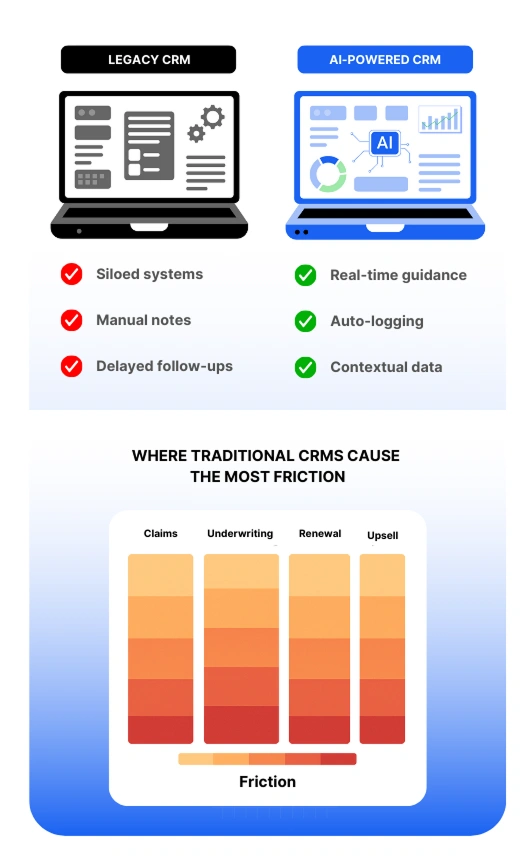
When executives ask, “Why now?” It’s often because the symptom picture has become too costly: poor agent productivity, disjointed client conversations, low cross-sell yield, and missed renewal opportunities.
Adding AI on top of an unprepared CRM stack only amplifies friction. Here’s where the real pressure lies.
What legacy systems fail to deliver today
- Data silos & disjointed systems: Many insurers run separate systems for policy admin, quoting, claims, and service, none of which talk to the CRM. That leads to duplication, stale data, and manual reconciliation.
- Poor agent visibility and context: Agents often lack real-time insights about the customer’s policy history, claims status, or prior interactions. They operate blind.
- Lag in data entry & follow-ups: Post-call tasks, data entry, and follow-ups get delayed, sometimes for hours, creating response gaps.
- Limited automation & orchestration: Legacy CRMs may support workflow rules but lack advanced automation, AI prompt integration, or orchestration across modules.
In a case with a UK health insurer, Datamatics automated their multi‑life underwriting process by migrating legacy underwriting logic into a CRM and rules engine, reducing manual steps and improving throughput.
In contrast, the CRM must actively drive decision-making, signal the next best actions, and orchestrate operations to meet the demands of modern insurance attribution. AI and CRM need to be combined in this situation rather than remaining separate.
Customers want speed, personalization, and 24/7 support
Policyholders today expect more:
- Instant responses: No more hold music or multi‑day email delays.
- Personalized engagement: Suggestions, offers, and interactions should reflect their coverage, claims history, and profile.
- Always-on support: Chatbots, voice bots, or AI assistants filling gaps after office hours.
Kustomer notes that insurers who deliver top-tier CX generate 2–4× more new business and about 30% higher profitability than those lagging in customer experience.
Even in renewals, AI can boost engagement. Convin’s AI voice assistant, for instance, has helped agencies reduce operational costs by 60% and improve customer satisfaction by 27% when managing auto insurance renewals.
The bar has shifted: insurers are now competing as customer-experience businesses, not commodity risk underwriters.
AI makes real-time decisions possible, but only if CRM is ready
AI is powerful, but only when it can operate in the moment. That means your CRM must support:
- Real-time data ingestion: As conversations, interactions, and external signals stream in.
- Prompting & decisioning: AI must be able to pop alerts, guidance, or suggestions inline for agents.
- Feedback loops & continuous learning: The system should capture agent corrections and outcomes and feed them back to model training.
- Orchestration across modules: E.g., after a call, the system must update the policy module, send follow-ups, and schedule tasks automatically.
In one case, Convin integrated its conversational AI with a CRM to allow for tailored notifications and reduce churn through proactive engagement.
If your CRM can’t handle AI signals in real time, it becomes a bottleneck, not an enabler.
Capture, analyze, and act on every client interaction!
What’s Driving the Shift to AI‑Integrated CRMs
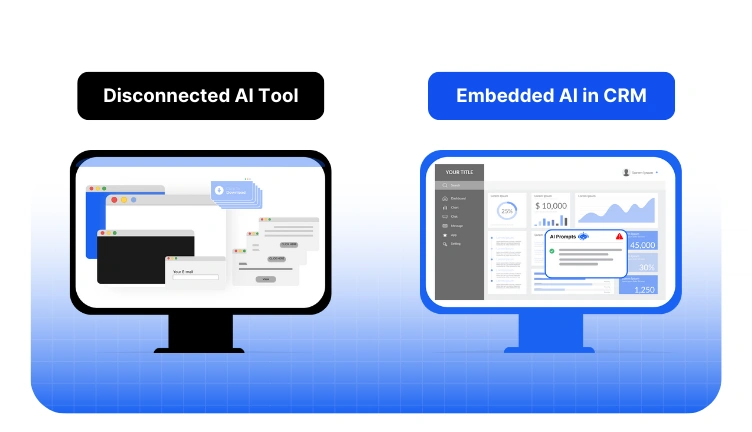
As insurance leaders evaluate modernization, several deep technology and market forces are pushing AI & CRM to converge. Understanding these shifts helps you architect purposeful transformation, not a scattered patchwork.
Embedded intelligence vs. disconnected AI tools
- In older models, AI or analytics tools lived in separate silos. Agents had to switch applications to view AI outputs or recommendations.
- Today, the trend is toward embedded AI, meaning predictions, prompts, and insights appear directly in the CRM interface.
- Embedded AI allows for context-aware suggestions, e.g., “This customer is likely to lapse; offer a retention incentive now.”
- Decerto discusses how CRMs are being rebuilt with automation, predictive analytics, and AI as native layers.
This shift ensures agents don’t “leave their flow” to consult another system, and it minimizes friction, latency, and adoption roadblocks.
Agentic AI systems are changing underwriting and claims
A growing frontier: multi-agent systems where specialized AI “agents” collaborate behind the scenes:
- One agent may focus on pricing/risk, another on regulatory checks, another on customer propensity.
- These AI agents feed into CRM or orchestration layers to drive decisions downstream.
- In insurance process mining research, deploying LLMs to classify claim parts automated a previously manual bottleneck, showing how specialized AI layers can transform workload.
- The key is orchestration: ensuring these agents rub together smoothly, without suggestions that conflict or overwhelm users.
For example, an underwriting AI might flag a high risk, an agentic system might reconcile that with recent claims, and the CRM must reconcile the insight for a quote decision all in one glance for the underwriter.
Predictive models help boost sales and retention
Predictive analytics is already critical in insurance, and embedding it into CRM is supercharging its impact:
- Predict the next-best-action: when to call, what offer to pitch, and whether a customer is churn-prone.
- Cross-sell & upsell scoring: which risk segments respond to which add-ons?
- Churn prediction: detecting signs of policy lapse before it happens.
In AI insurance use-case studies, insurers using personalization and predictive cross-sell report 25% higher cross-sell effectiveness and 15–20% retention uplift.
When these models tie directly into agent workflows (e.g., prompts in CRM), they become action levers, not reports.
Track policy conversations. Coach agents. Win more business.
This blog is just the start.
Unlock the power of Convin’s AI with a live demo.

The Roadblocks That Slow Insurance Transformation
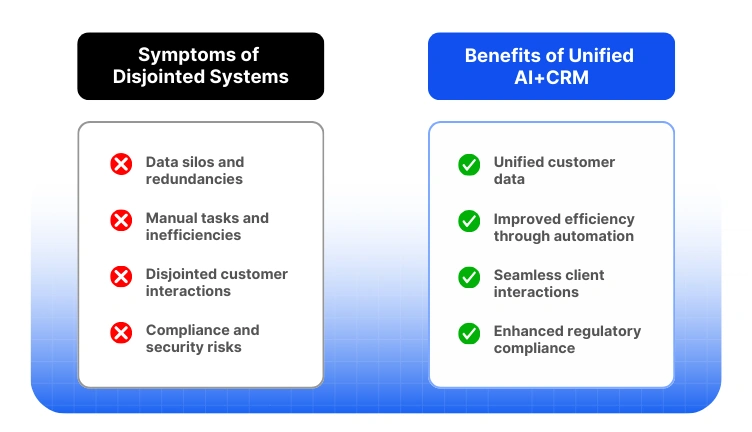
Even with clear benefits, many insurance firms struggle to cross the finish line. The barriers are not primarily technical; they’re organizational, cultural, and architectural. Let’s unpack the three biggest.
Juggling multiple platforms and disjointed data
- You likely have policy admin systems, claims platforms, legacy underwriting tools, and agent portals all with different schemas and latency.
- Integrating AI into CRM means reconciling data from all these systems in real time.
- Data freshness, consistency, schema mismatch, and API latency become huge challenges.
- DMACO, in a blog on insurance CRM integration, lists fragmented data as a primary hurdle in achieving a holistic customer view.
- Without a concerted data strategy (ETL, APIs, event‑driven sync), AI outputs may act on stale or incomplete data. Architecture is therefore important; event buses, microservices, canonical data models, and API layers are no longer optional.
Compliance concerns and lack of explainability
- Insurance is heavily regulated. Decisions tied to premiums, underwriting, and claims must be explainable, auditable, and fair.
- Black-box AI models that suggest risk ratings or declines create compliance and reputational risk.
- The innovative application of AI systems frequently deviates from the intended design, necessitating a robust human-AI interaction design, according to research on explainable AI in insurance.
- In healthcare insurance, studies find that explicit mention of AI reduces trust among customers.
- You need guardrails: confidence thresholds, human-in-the-loop checks, audit trails, and feedback loops.
Without explainability baked in, you risk failing regulatory audits or worse, harming customer trust.
Resistance to AI from internal teams
- Agents, underwriters, or claims adjusters may distrust “AI prompts” or fear automation replacing them.
- If AI outputs often contradict expert opinion, agents override it and call it useless.
- Organizational change, training, performance incentives, and adopting a culture that values augmentation are essential.
- Many pilots fail because the AI is “switched on,” but agents don’t trust it or turn it off in under a week.
- As AI becomes more visible, the human factors (transparency, trust, and UI/UX) determine adoption.
Thus, successful transformation requires not just a tech stack but a change management strategy.
Key Benefits of CRM for Insurance Agencies and Companies
- Centralized Customer Data and 360° Client Views
Siloed data is one of the biggest roadblocks for insurance agencies. A modern CRM eliminates that by aggregating customer information into a unified platform.
Benefits:
- Combines policy details, claim history, communication logs, and personal data.
- Provides agents with a complete view of the customer journey.
- Improves service delivery, decision-making, and personalization.
With a 360° view, agents no longer rely on guesswork as they make data-driven decisions in real time.
- Automated Follow-Ups and Task Management
Manual follow-ups are a productivity killer. AI-enhanced CRMs automate them to reduce drop-offs.
What it enables:
- Triggered follow-up reminders based on customer behavior or policy lifecycle.
- Auto-generated tasks for agents after specific actions (e.g., quote download).
- Pre-set workflows for renewals, claims, and onboarding.
Result: No missed opportunities, improved operational efficiency, and better conversion rates.
- Enhanced Policy Management and Renewal Tracking
Policy management is high-touch and high-risk if not automated.
Here’s how AI-CRMs improve it:
- Automatically detect policies nearing expiration and prompt renewal outreach.
- Track multiple policies per customer for bundled service reminders.
- Recommend coverage enhancements or policy upgrades based on usage data.
Long-term revenue depends on proactive engagement and a decrease in churn.
Upgrade your CRM stack. Automate everything but empathy.
How Salesforce Insurance Integration Delivers Business Impact
Salesforce, with its powerful CRM backbone and AI capabilities, is redefining how insurance companies manage sales and service. When customized for insurance workflows, it becomes a high-impact tool for automating processes, increasing agent productivity, and driving smarter decisions.
Real-Time Customer Interactions and AI-Driven Suggestions
Salesforce's integration with AI (Einstein) enables intelligent, contextual service at scale, providing "next-best actions" during interactions, identifying at-risk customers, and suggesting cross-sell opportunities. It also supplies real-time templates or scripts for agents, effectively acting as a strategist within the CRM to enhance communication.
Streamlined Claims Handling and Service Automation
Salesforce enhances customer satisfaction in claims handling with key automations: auto-routing claims to appropriate adjusters, extracting data from emails/forms for claim fields, and providing real-time status updates through omnichannel alerts. These automations result in faster, error-free, and transparent claim cycles.
Cross-Sell and Upsell with Predictive Analytics
Salesforce enhances sales processes through predictive insights, enabling the identification of customers for upgrades, matching profiles with trending insurance bundles, and launching proactive sales campaigns based on AI recommendations, ultimately increasing revenue per customer and agent productivity.
Businesses use Salesforce's insurance integration to optimize every touchpoint, not just manage customer relationships. The result is a faster, smarter, and more scalable approach to insurance operations that’s built for the future.
HubSpot Insurance CRM: Streamlined and Scalable
For insurance agencies looking for agility and ease of use, HubSpot offers a streamlined CRM that scales effortlessly. Its intuitive interface, automation features, and integration flexibility make it an ideal fit for fast-moving insurance teams.
Intuitive Interface for Sales and Service Teams
HubSpot's minimal learning curve benefits insurance teams with features such as visual drag-and-drop deal pipelines, no-code automation for repetitive tasks, and the ability to create custom dashboards without technical dependencies, facilitating faster adoption and scalable usage for agencies with lean teams.
Automating Campaigns, Follow-Ups, and Lead Scoring
HubSpot excels in marketing and sales automation, offering lead scoring models to rank prospects by their behavior, customized email workflows for different policy interests and customer stages, and auto-reminders for abandoned quotes and inactive leads. This comprehensive approach ensures that opportunities are not missed and that communications are appropriately timed.
Integrations with Quoting, Billing, and Support Systems
HubSpot's integration capabilities foster a cohesive technology ecosystem by connecting various tools such as quoting platforms for different insurance lines, billing systems for payment management, and helpdesk applications for enhanced service delivery. The use of AI to synchronize data among these tools aids insurers in minimizing duplication, errors, and compliance risks.
Insurance teams can accomplish more with less complexity, manual labor, and time spent switching between systems thanks to HubSpot. With the right integrations and AI enhancements, it becomes a powerful driver of sales and service efficiency.
Let Convin auto-log calls, emails, and next steps - accurately.
AI + CRM: Driving Data-Driven Decisions in Insurance
When AI meets CRM in the insurance industry, the result is powerful, data-driven decision-making. From predicting customer behavior to automating personalization, AI transforms static data into actionable intelligence.
Analyzing Customer Behavior to Boost Retention
Predictive analytics spot patterns agents can’t.
Retention triggers AI can detect:
- Decline in engagement or fewer service interactions.
- High number of unresolved support tickets.
- Missed payments or complaints.
CRMs then flag these accounts for immediate retention outreach, preventing churn before it happens.
Personalized Communications Powered by Machine Learning
AI provides the sense of understanding that every consumer seeks.
Capabilities include:
- Predicting the best communication channel and time.
- Crafting message content based on tone, preferences, and policy type.
- Recommending upsell content tailored to customer segments.
The result? Higher open rates, response rates, and trust in the brand.
Reducing Manual Data Entry and Routine Tasks
Admin work drains time from sales.
AI reduces it by:
- Logging calls and emails automatically.
- Transcribing and tagging call summaries.
- Updating policy status or CRM fields in real-time.
It guarantees data accuracy, which results in cleaner reporting and improved compliance, in addition to saving time.
Future-Proofing Insurance Teams with CRM-AI Automation
Empowering Cross-Functional Teams with Insights
An AI-powered CRM turns into a central intelligence engine and isn't just for sales.
Who benefits:
- Marketing identifies campaign ROI and segments.
- Underwriting uses CRM insights to adjust product pricing or eligibility.
- Execs track KPIs in real-time for faster decision-making.
A unified data layer helps break silos and drive coordinated growth strategies.
Improving Customer Experience and Satisfaction
AI ensures agents deliver faster, smarter, and more personalized service.
Experience enhancements:
- Agents access full customer context instantly.
- AI suggests empathetic messaging or quick fixes based on sentiment.
- Consistent communication across channels—from call to chatbot to email.
This translates to fewer escalations, higher satisfaction scores, and more referrals.
Supporting Long-Term Growth and Compliance
Scaling comes with risks. AI-enabled CRMs help navigate them safely.
Support for future growth:
- Auto-audit trails for every interaction and action.
- Data governance tools that flag risky behavior or anomalies.
- Scalable workflows that grow with your team and book of business.
Simply put, you're building for the next ten years rather than just solving problems for the present.
Insurance companies gain a significant advantage by integrating AI into CRM workflows, which enables them to engage customers proactively, lower customer attrition, and make more informed business decisions based on real-time insights.
Turn customer intent into automated follow-through.
How Convin Brings AI and CRM Together for Insurers
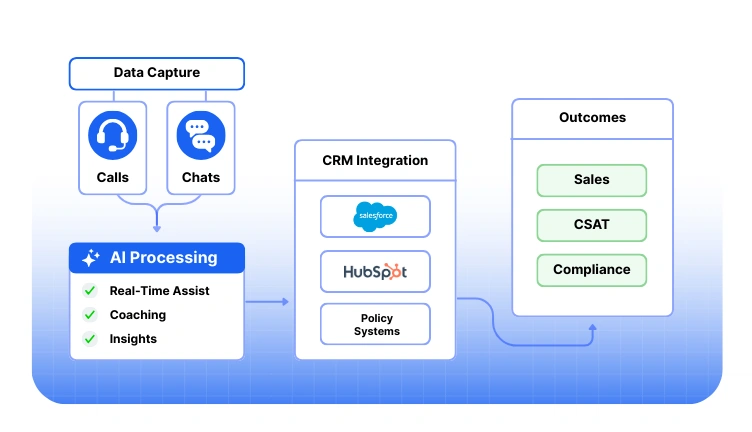
This is your decision moment: how does Convin deliver the architecture, integration, and outcomes you need?
Real-time coaching and support during customer calls
- Real-Time Agent Assist: As agents converse, Convin surfaces context, key prompts, next-best questions, compliance cues, and offers suggestions.
- This means agents never lose flow or forget critical disclosures.
- In conversational AI blogs, Convin states that this agent assist cuts AHT (average handling time) by up to 25% and reduces post-call work.
- The coaching layer also captures real-time corrections, allowing models to learn continuously.
CRM automation: summaries, notes, and compliance done instantly
- After each call or interaction, Convin auto-generates call summaries, tags important fields, and logs data into CRM fields (Salesforce, HubSpot, insurance CRMs).
- It also ensures compliance: flagging missing disclosures, checking mandatory statements, and creating audit trails.
- Because this happens automatically, agents spend less time on after-call work and more time selling or assisting.
- Convin integrates via API-based connectors to existing CRMs, so you don’t need to rebuild your CRM stack.
Advanced analytics for QA, CSAT, and revenue tracking
- Convin’s platform includes conversation intelligence, sentiment analysis, and QA scoring.
- The system tracks metrics such as NPS, CSAT, compliance violations, agent performance trends, and conversation-level insights.
- These analytics feed back into training, coaching, and model refinement.
- In claims mode, Convin’s AI can score risk, detect fraud, and flag anomalies for human review.
Together, these modules form a closed-loop system: live intelligence → agent assist → automation → analytics → feedback → model improvement.
Measurable Results from Convin’s AI‑Powered Integration
Let’s validate this with numbers and a real-world case that resonates with decision-level execs.
21% higher sales, 60% faster ramp-up, 27% higher CSAT: Convin's AI integration results in a 21% increase in sales, a 27% improvement in customer satisfaction (CSAT), and enables new agents to accelerate their ramp-up time by 60%. These metrics highlight significant short-term benefits to the business.
100% compliance monitoring with automated QA: Convin provides real-time compliance checking and conversation intelligence, achieving complete QA and audit monitoring without manual review. This innovation reduces compliance risk, oversight burden, and error leakage, which is especially valuable in the highly regulated insurance sector.
Example: Convin’s impact on a high‑volume insurance call center
Suppose you run a call center handling 500,000 interactions annually. Before Convin:
- Agents spend 20% of their time on after-call data entry
- Compliance violations show up post facto
- Cross-sell rates hover low, agent ramp-up is slow
After integrating Convin:
- Real-time coaching cuts average handling time by 15–25%
- Automated call summaries and CRM syncing reduce after-call work by 40–60%
- Cross-sell & upsell prompts drive a 20%+ bump in sales
- Compliance and QA are continuously monitored, reducing audit overhead
- Ramp-up time for new agents shortens, enabling you to scale quickly
In this hypothetical, Convin becomes a direct lever of revenue and efficiency, not just a cost center.
Redefine Insurance with AI-Driven CRM
By 2025, integrating AI-powered CRM into insurance is essential, not optional. The gap between what modern expectations are and where legacy systems fall short is widening. The choice for senior leaders, CTOs, and CROs is not whether to act, but rather how quickly and carefully.
Real-time agent assistance, predictive models, and embedded AI have all been shown to be changing the competitive landscape. Data silos, compliance, and organizational resistance are some of the obstacles that many pilots encounter, as you have witnessed. Convin has demonstrated how to integrate analytics, coaching, automation, AI, and CRM into a logical and quantifiable whole.
Now is the time to take action if you want to turn your insurance operations from inert systems into proactive, data-driven growth engines.
Book a demo with Convin to let us show you what it looks like when your CRM becomes your smartest asset, and not your bottleneck.
FAQs
1. What is the best CRM for small insurance agencies?
For smaller agencies, HubSpot insurance CRM is ideal due to its simplicity, affordability, and easy integration with marketing and quoting tools.
2. Can a CRM help with cross-sell strategies in insurance?
Advanced CRM solutions use AI to identify cross-sell opportunities based on customer data and past interactions, helping boost sales.
3. How does CRM automation improve team productivity?
CRM automation reduces manual work like data entry, follow-ups, and scheduling. This lets insurance teams focus more on client interactions.
4. Is real-time customer data important for insurance sales?
Absolutely. Real-time data ensures agents respond quickly with the right offers or service, enhancing both conversions and customer satisfaction.
5. How do CRMs support social media in insurance marketing?
Modern CRMs integrate with social media platforms to track engagement, collect leads, and tailor campaigns for insurance companies.


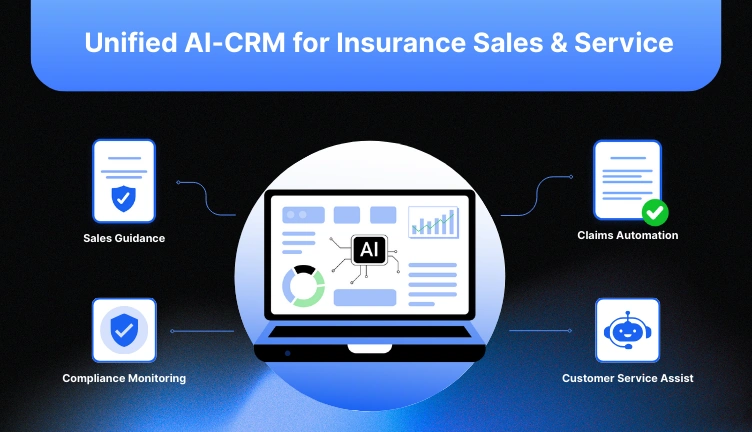



.avif)

.avif)